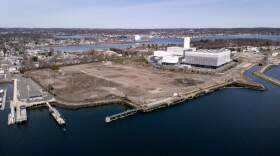A new report explores New Hampshire’s potential to provide infrastructure for offshore wind, showing the state’s infrastructure could play a role in the development of the renewable energy resource in the Gulf of Maine, but faces some challenges to do so.
The report, released Thursday by three state agencies, also explores how wind power could help the region reduce greenhouse gas emissions.
Mark Sanborn, assistant commissioner at the Department of Environmental Services, led the study.
“[The report] confirmed the reasons New Hampshire is investigating offshore wind in the Gulf of Maine and its potential benefits to the state and the region,” he said.
Among other findings, the report shows New Hampshire could be an “attractive” place to connect offshore wind generators to the region’s electricity grid, given challenges to interconnection in Maine and Massachusetts. But with the current transmission network, the state would only have the ability to connect to “relatively modest” amounts of wind generation, the report says.
Maine likely offers the shortest interconnection distance, the report says, but has other issues, including a question of transmission capacity due to the state’s development of a transmission corridor to Quebec.
In Massachusetts, challenges the report identified include the state’s distance from likely locations for wind turbines and the potential for difficult siting given the busy nature of Boston.
Both Maine and Massachusetts have significantly more coastline than New Hampshire.
In New Hampshire, recently retired electricity generating facilities like the Schiller Station could become points of interconnection, according to the study.
“Some of the legacy infrastructure we have in the Seacoast that right now isn't being completely utilized may have a new life and a new opportunity through offshore wind operations if we are to go forward,” Sanborn said.
Connecting offshore wind with the grid in New Hampshire would require upgrading existing transmission infrastructure. New Hampshire is a net exporter of electricity, meaning transmission lines in the state are likely to be more heavily loaded, and might not have the capacity for exporting offshore wind, the report says. Retiring existing fossil fuel resources could help free up some of that space, according to the study.
Communities that host cable infrastructure could negotiate Community Benefits Agreements with developers of those projects.
The study also says offshore wind could reduce New Hampshire’s greenhouse gas emissions, working in tandem with efforts to electrify transportation, New Hampshire’s largest source of in-state emissions.
Chris Skoglund, director of energy transition at Clean Energy New Hampshire, said offshore wind’s impact on emissions could be complicated. Skoglund has experience doing greenhouse gas inventories for the state.
“It's hard to tease out the individual impact of wind offshore because we're going to be seeing a transformation of the entire energy system as a result of declines in the upfront costs for electric vehicles [and] for these heat pumps,” he said.
But, he said, the renewable energy source could help meet new demand for electricity with resources that emit less greenhouse gas, keeping new generation assets powered by fossil fuels off the system.
New Hampshire has reduced its emissions significantly since 2004, but those reductions have been highly influenced by steps other states have made to reduce the demand on our regional grid. And emissions are projected to stay the same through 2030 without new policies, the report says.
Offshore wind could help reduce emissions associated with New Hampshire’s energy use whether power comes to shore in the Granite State or elsewhere in New England, according to the study, given the interconnected nature of the region’s energy system.
The report also gathered information on the state’s existing port infrastructure, including the Market Street Marine Terminal. A proposed project would repair the terminal’s main wharf, which needs rehabilitation, according to a 2017 inspection.
The Department of Business and Economic Affairs has created a registry where businesses can add their name to a list of those interested in participating in offshore wind projects and operations.
Next comes another study, Sanborn said. State agencies plan to do an assessment of the energy, environmental, and economic impacts of offshore wind.








